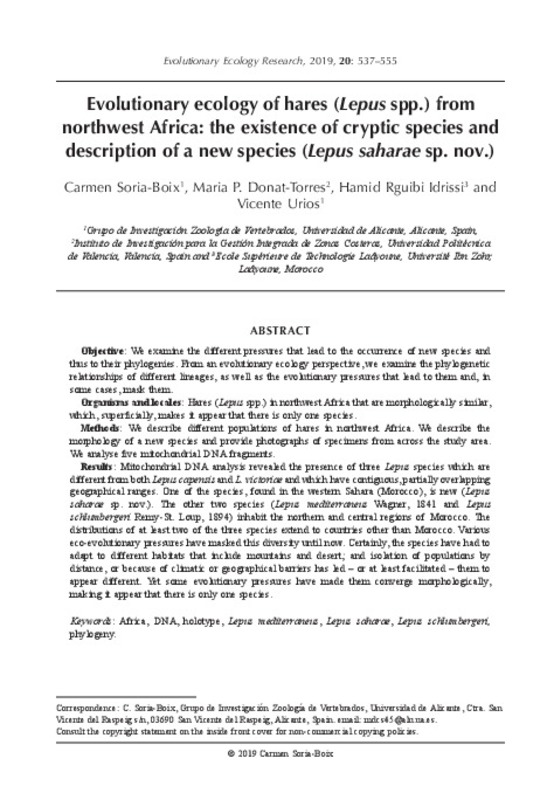JavaScript is disabled for your browser. Some features of this site may not work without it.
Buscar en RiuNet
Listar
Mi cuenta
Estadísticas
Ayuda RiuNet
Admin. UPV
Evolutionary ecology of hares (Lepus spp.) from northwestern Africa; The problem of cryptic species and the description of a new species (Lepus saharae sp. nov.)
Mostrar el registro sencillo del ítem
Ficheros en el ítem
| dc.contributor.author | Soria-Boix, Carmen
|
es_ES |
| dc.contributor.author | Donat-Torres, Maria P.
|
es_ES |
| dc.contributor.author | Rguibi Idrissi, Hamid
|
es_ES |
| dc.contributor.author | Urios, Vicente
|
es_ES |
| dc.date.accessioned | 2021-06-12T03:34:09Z | |
| dc.date.available | 2021-06-12T03:34:09Z | |
| dc.date.issued | 2019-09 | es_ES |
| dc.identifier.uri | http://hdl.handle.net/10251/167876 | |
| dc.description.abstract | [EN] Objective: We examine the different pressures that lead to the occurrence of new species and thus to their phylogenies. From an evolutionary ecology perspective, we examine the phylogenetic relationships of different lineages, as well as the evolutionary pressures that lead to them and, in some cases, mask them. Organisms and locales: Hares (Lepus spp.) in northwest Africa that are morphologically similar, which, superficially, makes it appear that there is only one species. Methods: We describe different populations of hares in northwest Africa. We describe the morphology of a new species and provide photographs of specimens from across the study area. We analyse five mitochondrial DNA fragments. Results: Mitochondrial DNA analysis revealed the presence of three Lepus species which are different from both Lepus capensis and L. victoriae and which have contiguous, partially overlapping geographical ranges. One of the species, found in the western Sahara (Morocco), is new (Lepus saharae sp. nov.). The other two species (Lepus mediterraneus Wagner, 1841 and Lepus schlumbergeri Remy-St. Loup, 1894) inhabit the northern and central regions of Morocco. The distributions of at least two of the three species extend to countries other than Morocco. Various eco-evolutionary pressures have masked this diversity until now. Certainly, the species have had to adapt to different habitats that include mountains and desert; and isolation of populations by distance, or because of climatic or geographical barriers has led - or at least facilitated - them to appear different. Yet some evolutionary pressures have made them converge morphologically, making it appear that there is only one species. | es_ES |
| dc.language | Inglés | es_ES |
| dc.relation.ispartof | Evolutionary Ecology Research (Online) | es_ES |
| dc.rights | Reserva de todos los derechos | es_ES |
| dc.subject | Africa | es_ES |
| dc.subject | DNA | es_ES |
| dc.subject | Holotype | es_ES |
| dc.subject | Lepus mediterraneus | es_ES |
| dc.subject | Lepus saharae | es_ES |
| dc.subject | Lepus schlumbergeri | es_ES |
| dc.subject | Phylogeny | es_ES |
| dc.subject.classification | BOTANICA | es_ES |
| dc.title | Evolutionary ecology of hares (Lepus spp.) from northwestern Africa; The problem of cryptic species and the description of a new species (Lepus saharae sp. nov.) | es_ES |
| dc.type | Artículo | es_ES |
| dc.rights.accessRights | Abierto | es_ES |
| dc.contributor.affiliation | Universitat Politècnica de València. Departamento de Ecosistemas Agroforestales - Departament d'Ecosistemes Agroforestals | es_ES |
| dc.description.bibliographicCitation | Soria-Boix, C.; Donat-Torres, MP.; Rguibi Idrissi, H.; Urios, V. (2019). Evolutionary ecology of hares (Lepus spp.) from northwestern Africa; The problem of cryptic species and the description of a new species (Lepus saharae sp. nov.). Evolutionary Ecology Research (Online). 20(5):537-555. http://hdl.handle.net/10251/167876 | es_ES |
| dc.description.accrualMethod | S | es_ES |
| dc.relation.publisherversion | https://www.evolutionary-ecology.com/issues/forthcoming/ar3207.pdf | es_ES |
| dc.description.upvformatpinicio | 537 | es_ES |
| dc.description.upvformatpfin | 555 | es_ES |
| dc.type.version | info:eu-repo/semantics/publishedVersion | es_ES |
| dc.description.volume | 20 | es_ES |
| dc.description.issue | 5 | es_ES |
| dc.identifier.eissn | 1937-3791 | es_ES |
| dc.relation.pasarela | S\422431 | es_ES |
| upv.costeAPC | 640 | es_ES |






